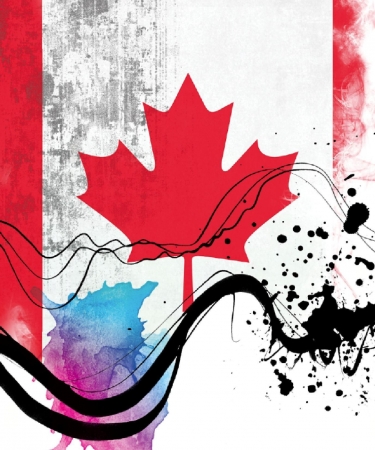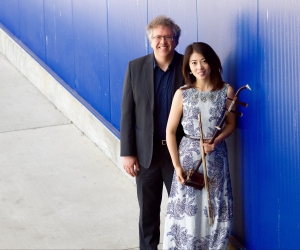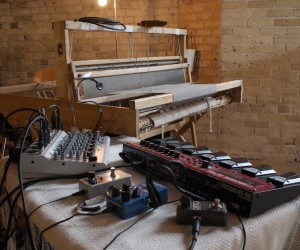
In 1981 in a small town called Dunedin in New Zealand, a trio of young musicians called The Clean, recorded a handful of fuzzy, sloppy pop songs on a four-track Portastudio. For connoisseurs of what is now known as indie-pop, their infectious energy and heartfelt yearning have stood the test of time. Theirs was music made half a world away from major music centres New York and London. And it marked the beginning of technology’s role in decentring music and empowering the margins.
DIY—do-it-yourself. Inspired by the punk movement’s rebellious stance against the centralization and big-budget production of the commercial music industry in the ’70s, the DIY revolution has been the defining ethos of the last thirty-five years of musical creativity. Home recording. Homemade records. Thanks to mass-media dissemination, pop music is all about hitting the “Record” button.
Punk was more than just a fashion statement: cultural theorists like Greil Marcus correctly identified it as the pop-music equivalent of modernist movements such as Dada and the Situationists. Just as modernist composers—from Schoenberg to Cage, Stockhausen to Boulez—rebelled against and overturned conventional notions of tonality, instrumentation, and score, punk rockers rejected the music industry’s standards of decorum, musicianship, and production values.
By the early ’90s, a new term had been coined in the rock underground: lo-fi—low-fidelity. American indie bands like Pavement, Sebadoh, and Guided by Voices led the charge. Championed at the time by the late Kurt Cobain of Nirvana—the most unexpected of rock stars—these groups made tape hiss and flubbed intros palatable to a wider audience while in search of the perfect pop song. Yet only in pop music could a subgenre be defined by the quality of its recording; you couldn’t imagine jazz or classical artists even giving the issue a thought.
Most of these artists were making cheap records out of economic necessity rather than aesthetic choice, yet a discernible aesthetic quality arose: an off-the-cuff immediacy and intimacy—the ineffable quality of authenticity—that had been lost in the highly produced pop records of the ’80’s.
In the twenty-first century, however, the ubiquity of digital recording has not only put countless recording studios out of business, it has also rendered the question of lo-fi moot. Now it is truly a choice, not a necessity. Anyone can make a hi-fi, studio-quality recording in his or her bedroom.
A new generation of independent musicians has come of age without questioning their own abilities to create their own sound worlds in the comforts of their own homes; meanwhile, the Internet has made the entire history of recorded music available as a musical influence. The increasing accessibility of computers and audio software has sparked a second wave of the DIY revolution, and it’s redefining what we call pop. And Canada—like New Zealand, once considered remote and irrelevant—has become one of the world’s major producers of this new spirit of pop adventurism, one that runs the complete spectrum of tempos, atmospheres, textures, and, yes, fidelities.
Braids: How to cook an ambient pot roast
Native Speaker is a collection of seven songs that is, given that the average age of its creators is somewhere around twenty years old, shockingly assured. The debut full-length album by the Montreal quartet Braids begins with a burble of flowing water, the sound of which will be familiar to any student of musique concrète. This cross fades into an equally liquid, delay-treated guitar line reminiscent of Steve Reich’s Electric Counterpoint. Despite these experimental music signifiers, once Raphaelle Standell-Preston’s voice makes its entrance, it’s clear that this is a pop group. Icelandic electro-pop queen Björk is the most common reference point in terms of Standell-Preston’s vocal acrobatics, though other commentators have compared her voice to those of Régine Chassagne of the fellow Montreal band Arcade Fire and Elizabeth Fraser of the Cocteau Twins.
That last comparison may be the most interesting, because in the late ’80s the Scottish trio the Cocteau Twins was at the forefront of a British movement once labelled dream pop. Pushed out of cult status circa 1991 by fashionable groups like Ride and Lush, and the heavier, more guitar-oriented My Bloody Valentine and Swervedriver, dream-pop eventually became known in North America as shoegaze—an affectionate shorthand term for the genre whose groups suffered insults for having no stage presence. This is music that, in a brilliantly devious and unexpected fashion, simultaneously fades into the background yet demands your full attention.
Braids’ back-story is one of the wallflower who suddenly steps onto the dance floor. Forming as The Neighbourhood Council while still in high school in Calgary, Braids became Braids shortly after their collective move to the Canadian indie-music mecca of Montreal. Though shy and self-effacing in person, the group is clearly ambitious: even before their name change, they had talked their way onto bills with their art-rock heroes, Deerhunter.
Released in early 2011, Native Speaker has already attracted rave reviews from the likes of The New York Times, The Globe and Mail, and the ever-influential Pitchfork. “Native Speaker is very much like a pot roast,” says Standell-Preston, when challenged to compare the self-produced record to a home-cooked meal. “It took a very, very long time to make; the songs took a year and a half to write and then nine months to record.”
This leisurely pace would have been unthinkable twenty years ago, when My Bloody Valentine bankrupted their U.K. label Creation Records, spending hundreds of thousands of pounds on studio time to complete their magnum opus and swan song, Loveless. This, of course, is the luxury of home recording: the group recorded the album almost exclusively in the Logic Pro audio environment, in a home studio consisting of “a garage, a spare room, and the kitchen pantry,” according to bassist Taylor Smith. In this sense, Pitchfork reviewer Ian Cohen is correct in pointing out that Native Speaker also “embodies the best ideals of post-rock”—another ’90s U.K. movement that gained profile when it crossed the pond. The original British post-rock groups like Moonshake, Bark Psychosis, and Seefeel were among the first to combine traditional rock instrumentation with electronics, sampling, and early home-audio software. “Technology plays a huge role in the music that we construct,” concurs Standell-Preston. “Electronic devices are the means to an end of an idea that was first in our head. Sometimes, though, you can stumble across a beautiful effect that you had not at first imagined.”
The new pop adventure on which Braids takes the listener with Native Speaker is one of lushly orchestrated electronics, guitars, and beautifully effected vocal harmonies that snake around gently pulsating drums, supporting a narrative that slowly unfolds over song structures that often hit the eight-minute mark. The listener is guided through this wonderful alien sound-world by Standell-Preston’s commanding voice, seemingly mature beyond her years—except that when you listen closely to the lyrics, you hear a young Albertan woman telling very familiar stories of teenage lust and suburban alienation. Mundane words, yes, but refreshing in their honesty—and still far from clichéd.
Grimes: Planet Claire
“Caladan,” “Shadout Mapes,” and “Sardaukar Levenbrech” are a few selections from the CD Geidi Primes. All the titles on this debut release by Grimes are lifted from Dune, Frank Herbert’s interplanetary sci-fi saga. The girl with the stage name Grimes does not hail from one of Herbert’s imaginary worlds; like the members of Braids, twenty-two-year-old Claire Boucher calls Montreal home.
Despite similar penchants for electronics and home recording—not to mention their friendship within the tight-knit Montreal music scene—these two artists don’t share much in common musically beyond their atmospheric, unearthly vocal approaches. Grimes’ music is much more influenced by modern dance music, at the same time as its reverb-drenched melancholy sometimes makes it sound like a long-lost ’80s synth-pop project. It also marks a challenge to our collective notions of what constitutes experimental music, since Boucher’s self-produced recordings are entirely the product of an untrained musician.
“I do consider my music experimental, because generally it’s kind of an experiment for me whenever I make something, even if it’s, like, ‘can I get this production to sound like [“Umbrella” singer] Rihanna?’” says Boucher. “But I’m not sure if people see it that way because I tend to work within pop structures. I feel like pleasurable music is often discredited because people think the avant-garde needs to be alienating. There’s lots of music that I consider experimental that isn’t treated as such in the media, such as [commercial R&B–hip-hop artist] Ciara, because the term doesn’t fit with her public image. Whereas there’s lots of music that gets labelled experimental on Pitchfork, just because the band’s image looks lo-fi.”
Though Boucher seeks to distance herself from lo-fi as we know it—and indeed, the image of four scruffy, guitar-wielding young men has now become a cliché that outstrips the original ideal of authentic, economical immediacy—her music does have a stripped-down, minimal aesthetic. The tracks on Geidi Primes and its 2010 successor Halfaxa often consist of simply a beat, a synth, and layer upon layer of Boucher’s voice. The young vocalist claims influences from R&B, medieval organum, Prince, and (again) the Cocteau Twins. Like Elizabeth Fraser, Boucher appears to be singing in an invented language, which adds to her music’s transportative power.
Boucher claims an intuitive approach to her writing process, but she isn’t trying to take her listeners to any particular planet in the Dune universe. “I feel like listening to music is a different experience for each person. Whatever it is that people want to get from my music, that’s what they should get.”
Like Braids, however, she is more certain of the positive force that the computer plays in her world building. “Without technology, I would have no interest in making music. I’m definitely not a huge fan of acoustic music—at least in terms of myself playing it. Without digital delays or MIDI,” she says with a laugh, “I would be very upset!”
Grimes’ magically reverb-drenched space-pop—combined with her striking, pixie-esque appearance—has garnered her notice worldwide. The Internet has allowed an artist with releases on a tiny label to receive attention from influential U.K. outlets like the NME, BBC Music, and The Guardian. And naturally, such profile-raising easily propels a young artist physically beyond her hometown.
Doldrums: The weather underground
The crack in the windshield is growing ever wider. The whiteout conditions are on the verge of truly whiting out the world. But the two twenty-somethings inside the minivan only seem mildly perturbed. Why would they let a little winter weather harsh their mellow? After all, they’re embarking on every young Canadian musician’s dream: touring the U.S. of A.!
In March 2011, Grimes did a three-week co-headlining tour of the eastern United States with Doldrums—who in many ways is her male and Torontonian mirror. Doldrums is the bandonym of twenty-one-year-old Airick Woodhead, who creates a melodious racket with just a sampling keyboard, a Kaoss pad, and his voice.
The “Grimes X Doldrums Tour” was documented by daily video tour-diary entries on Vimeo.com, which show off not just free-spirited on-the-road frivolity, but also a new take on indie-rock performance: both artists seem most in their element performing in tiny, art loft spaces such as Silent Barn—a DIY venue in the furthest reaches of Brooklyn—and getting up-close-and-personal with their audiences. Performing on the floor, with just a microphone and a few spartan electronics on stands in front of them, Grimes and Doldrums thrive at the centre of a freak-scene dance party.
Musically, Doldrums marks a surprise shift in Woodhead’s young career. Already experienced on the Canadian touring circuit with his remarkably successful high-school band Spiral Beach, Woodhead suddenly re-branded himself as Doldrums in early 2010. Whereas Spiral Beach was a somewhat straightforward, new-wave-inspired, four-piece rock group, Doldrums sees Woodhead chasing down elusive pop melodies over a fast-forward soundtrack of burbling synths, speedy drum tracks, eight-bit distortion, and—bringing to mind John Oswald’s Plunderphonics—cheekily cut-up samples of familiar pop-radio tracks (from “The Loco-Motion” to Jay-Z’s “Empire State of Mind”).
“Yeah, looks like we just passed the first anniversary,” says Woodhead, observing the birth of Doldrums. “I’m still in diapers though, and feel a huge capacity to continue evolving. I did the changeover from Spiral Beach to Doldrums when I was turning twenty. I’m glad I cashed in on my youth, but now I have to exploit being a twenty-something, culturally valid, musically subversive, free-form, public-servant–pervert.”
Like his comrade Grimes, Woodhead views Doldrums as an experimental music project inasmuch as it challenges him to push his own boundaries. But he’s not afraid to think big, either: “I love the idea of a genuine experiment in sound; trying out new parameters and seeing how they play out, inventing processes, entire worlds—this is where discovery comes from. Throw shit at the wall and see what sticks. Don’t use the term experimental to describe something just because it’s weird. In artistic experiments, the process is the same as scientific method, but the results are completely subjective rather than objective.”
Doldrums’ experimentation is visual as well as sonic: video has played a big role in his output so far, with his first official release a VHS tape of classic ’80s-style indie music videos—full of ancient found footage degraded through multiple copying. “Yeah, I was making a lot of videos last year for You Tube and was using a lot of analogue processing and fucked-up VCRs. A lot of my friends’ bands were putting out cassettes—so the VHS release was a little tongue-in-cheek, I guess.”
Weird Canada rising
The last few years have seen the re-emergence of supposedly dead formats like cassette tapes as a legitimate release vehicle for underground artists. Vinyl records are back in a big way, thanks to their superior sound quality, visual beauty and eminent collectability—the ephemeral nature of MP3s has made real-world artifacts that much more valuable. Short-run cassettes and CDRs have a similar fetish factor, but keeping track of all this music is next to impossible for all but the die-hards. Thankfully, Canadian contributions to this worldwide movement are being documented and collected online by the now-essential blog page, <www.weirdcanada.com>. United under the slogan “We Are Northernly” [sic], Weird Canada runs daily reviews of “New Canadiana” and makes tracks available for streaming.
“What the artists on Weird Canada share in common is a conviction to eternalize their creative expression by committing it to physical form by any means necessary,” explains the Edmonton-based site’s founder, Aaron Levin. “This conviction transcends genre, finances, and social–societal pressures.”
Levin started Weird Canada in 2009 after finishing his masters in mathematics at the University of Alberta. Seeking a break from academia, he applied for a music director position at community radio station CJSR 88.5 FM. “I came across a wild amount of new Canadian music that just wasn’t being supported at any level. Bands were releasing a single CDR, handing it out to friends, and then disappearing into a void, never to be heard by anyone outside of their immediate circle. Armed with this perception of a void, I decided to start Weird Canada to both preserve and capture this emergent scene.”
Levin’s support of this burgeoning movement of home-recorded Canadiana has resulted in widespread and near-unanimous support for his efforts. Weird Canada was rewarded with some more national attention when it was the surprise upset winner of CBC Radio 3’s Searchlight prize for Canada’s best music website, beating out more established sites, like <www.cokemachineglow.com> and <www.midnightpoutine.ca>.
What’s curious about Weird Canada’s movement into the spotlight is the intriguing notion of a new generation of “mainstream” indie-music fans getting turned on to not just the freshest neo-soul by Sean Nicholas Savage or Thomas or the heavy psych of Black Feelings or Ayal Senior, but also long-lost new–experimental music by the likes of Michael Snow. Weird Canada offers a page entitled “Departures Revisited,” which unearths out-of-print releases such as Snow’s 1972 Music for Piano, Whistling, Microphone and Tape.
Does Levin see a possibility for, or evidence of, crossover or cross-pollination between home-recorded DIY underground bands and the more traditionally serious, academic experimental music community? “I really hope so! But in my experience, the academic community has been unresponsive to these kinds of collaborations. I’m not sure if they think DIY experimental music is threatening to their academic positions, or if they just have a different perspective on the role the arts play in society, but it’s been hard to get their attention or get them involved. It’s a very different world than many emerging musicians’ fly-by-night operations.”
Weird Canada won the Searchlight prize with this message: “You cover vast distances in shitty vans. You work terrible jobs and tour in the summer. You sleep on floors and eat what you can. You don’t need a PR agent. You don’t need a FACTOR grant. You don’t need a $20,000 studio. You make music. You’ll do it by any means necessary.” That, to me, sums up the DIY spirit of new pop adventurism.
Then they expect you to pick a career
But on the other hand . . . Braids is now represented by a major U.S. booking agency. According to Standell-Preston, they have “started living in a van and have been on the road for three months,” playing increasingly larger venues. They do have a PR agent, and may well end up in a professional studio, recording the follow-up to Native Speaker. Or not. They may well continue on the DIY route. “We’re considering working with a producer, but in a bit of a twisted form,” says Smith. ”We want to find someone who can teach us and help us grow, not someone who will just do it for us. We are extremely hands-on and opinionated about our music, so letting someone else take the reins is very scary for us.”
These divergent musicians have their youth and that gives them the freedom to choose: they can go on long, grueling, agency-booked tours to work their record in multiple markets, or they can go on short, self-booked tours where they mostly have fun and make friends. Or hopefully some happy medium between the two—if such a thing is possible. Or, they can stay home and just make records.
Making a record is a form of immortality; going on tour and appearing on blogs are only steps towards making others aware you may have made something that might outlive you. It’s far too early to say if Canada’s new pop adventurists are creating something timeless. But I’d like to think some of them may make a record that in thirty years’ time might be revered in the same way that music lovers like myself cherish those early tracks by The Clean.
Audio: Crystal Ball (2010). Composed By Claire Boucher. Performed by Grimes.


